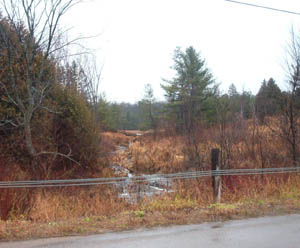Self-Guided Tours — Foresters Falls
|
Click to Print This Page See "Places of Interest" See Map The Byce Carding Mill. Grant Settlement road at Broome RoadDirectionsTake Foresters Falls road east out of the village until you come to the first intersection.
History (Excerpts from the writings of Elizabeth Byce MacDonald, 1894 - 1976)Henry Byce was born near Brockville, at Lynn. After the death of his first wife, he married Malena Coleman and moved to Westmeath. Some time after the birth of their child, Norman (November I7th I849) they moved to Ross Township and took up 160 acres of land. He dammed a small stream and flooded 60 acres to make a pond to create water power which he generated by causing the water to flow over a smaller dam on to a 30 ft. waterfall. The ruins of the old mill and the giant water wheel which power it were all hand made, even to the wooden screws and gears used in the mill, The mill remained for many years, even after it fell into disuse, and a piece of the mill resides in the Ross Museum grounds. Farmers brought their sheep’s wool to be carded and made into small rolls to be spun with spinning wheel into yarn from which they made clothing. Often wool was brought back to the mill for dyeing and home woven flannel was brought back for ?fulling?. It was put through great vats of suds and then dried; hanging on hooks, then pressed into folds with sheets of hot iron, and finally folded in to webs of sixty yards. Farmers came great distances, even from across the river, for fifty miles or more, with loads of wool to be processed. Henry Byce was widely known because of his mill business and he was also a very skillful doctor. He made medicine from herbs and he was sent for in cases of illness and patients were also brought to him. He set many bones, sewed up cuts, lanced infected sores and never lost a patient. On one occasion, a man had a bullet lodged in his leg with a piece of leather and their bedroom became a hospital for five weeks. Dr. Byce also had a small potash manufacturing business. (top) |
 Turn North onto the Grant
Settlement Road and proceed 3.7k until you come to the "Broome Road"
intersection to the right. This intersection was the site of the carding mill
and the stream can be seen crossing the road from the south.
Turn North onto the Grant
Settlement Road and proceed 3.7k until you come to the "Broome Road"
intersection to the right. This intersection was the site of the carding mill
and the stream can be seen crossing the road from the south.